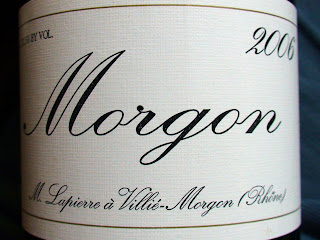By the Glass - Alsace Edition
Wines of the Alsace...who knew? From what I can tell, the wines of the Alsace are about as popular in the US as square dancing. Less so, actually, as there are some parts of the US where groups of people really love square dancing. Alsace wine lovers, and I'm guessing you're out there - where are you? Do you meet in secret? Do you suffer in quiet loneliness?
For whatever it's worth, I now count myself as one among your ranks. And I say this as a newborn babe. Let me be clear: I know essentially nothing about Alsace as a wine region. I won't even try to kid you - I know so desperately little. But I've been inspired by the quality of what I've tasted recently.
I'm sure that there is a river of Alsace plonk out there, as there is in Burgundy, the Loire Valley, and in every other great wine region. But what I've tasted so far has been excellent. White wines of great clarity and focus, lovely fruit, and great intensity without being weighty or sweet. I look forward to more from this region, especially as the cooler weather sets in. A cold December night, sausages, real sauerkraut, beef stew, cabbage soup, goulash, anything like that with a shimmering glass of Sylvaner? Yes, that's for me.
Here are notes on a few Alsace wines I drank recently. Please feel free to chime in with your own .02 cents on producers or specific wine that are worth trying.
2004 Audrey & Christian Binner Gewürztraminer Kaefferkopf, $20, Imported by Jenny & Francois Selections. If you think of Gewürztraminer as syrupy and sweet, fit only for the fieriest of Thai food, let this wine be your wakeup call. Bone dry - really. There is a viscous texture to the wine, and incredibly expressive tropical fruit on the nose, but the wine is not at all sweet. It is concentrated and aromatic with lychee and flowers, and a bitter mineral streak underneath. Intensely mineral on the palate with great acidity, there are splashes of fragrance that linger in the mouth after swallowing. Really a lovely wine, one that I could imagine drinking with a variety of meals.But mostly it made me pine for something like choucroute, the traditional "garnished" sauerkraut of the region. Garnished with sausages, potatoes, fatback, and lord knows what other salted meat. This bright and acidic wine would slice very nicely though all of that salt and fat, and might help you to actually finish your plate.
2005 Dirler Pinot Blanc Cuvée Vieilles Vignes, $27, Imported by Robert Chadderdon Selections. Gorgeous wine, really inspiring. Such great texture and intensity. Ripe orchard fruit, apple skins, a hint of yeast and lots of mineral character on the nose. Very pure, very fresh, and takes on weight with air time. Intense and fleshy in the mouth but still very lean, completely dry, and with very strong acidity. There is great length to the finish, and a lovely peach pit bitterness. The acidity and raw materials are strong enough here that I would imagine this wine would age quite well. Now that's an interesting question - other than Riesling, do Alsace wines age well?
2005 Albert Boxler Sylvaner, $23, Imported by Robert Chadderdon Selections. My favorite of those I tasted so far, this is just amazing wine. It starts slowly, but on the nose it builds to a crescendo of bright orchard fruit and lime peel, with bitter minerals running underneath. Such a rich and deep nose, so enticing! Absolutely pure and fresh. Great acidity frames the incredibly clear flavors of ripe fruit and bitter minerals. Great balance and length, and a whole lot of character. This is probably one of the lowest still wines on the Boxler totem pole, and it is truly excellent - it shimmers with life. And now I read that Sylvaner is being systematically replaced by other grapes in Alsace. About how the wines are unpopular. Say it ain't so. I've had two Sylvaners in the past few weeks and they were both wonderful, and inexpensive.
2006 Domaine Weinbach Riesling Cuvée Théo, $37, Imported by Vineyard Brands, Inc. This also started slowly (am I drinking this way too young?), but took on some weight with time. Wet stones and lime peel on the nose, hints of apple skins. Clean and fresh in the mouth with attractive mineral and fruit, and an athletic and nervy body, a bit tense. It is a lean and mineral style of wine, and seems like it would be a perfect accompaniment to cold poached salmon with cucumber and dill, or smoked sea trout, or something like that. We enjoyed it with sea scallops in a creamy curry reduction, roast baby turnips and braised turnip greens. Tasty, but the wine is almost too fine for that meal.



























